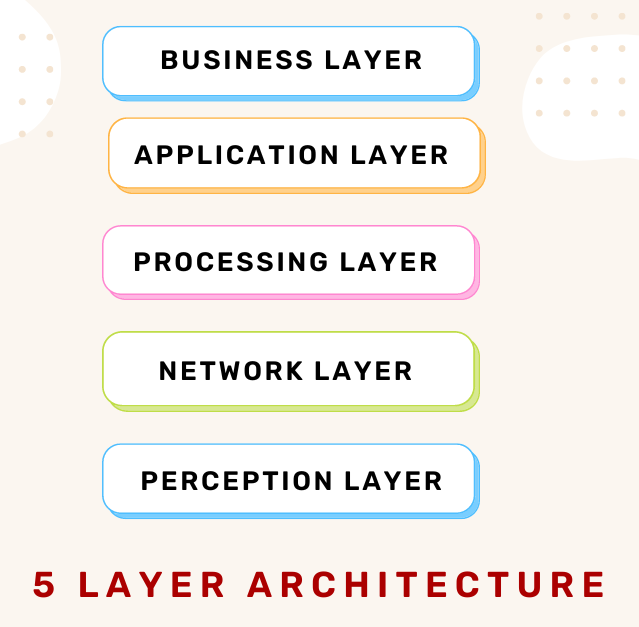5 Layer Architecture
The 5-layered Architecture of IoT is a detailed version of a 3-layer Architecture of IoT. The 5 layers are as follows:

1. Perception Layer is a physical layer, which has sensors for sensing and gathering information about the environment, is the perception layer. Sensors and embedded systems are primarily used in this. Based on the requirements, these collect large amounts of data. Edge devices, sensors, and actuators that communicate with their surroundings are also included. It detects some physical parameters or recognises other intelligent objects in the environment. This layer is responsible for data collection.
2. The transport layer or Network Layer The network layer is responsible for connecting other smart things, network devices, and servers. The information gathered by these devices must be distributed and saved. The network layer is in charge of this. It connects intelligent objects with other intelligent/smart objects. It is also responsible for data transfer. The network layer connects smart objects, network devices, and servers. Its capabilities are also used to transmit and process sensor data. Networks such as wireless, 3G, LAN, Bluetooth, RFID, NFC, and 3G are used here to transmit information from the perception layer to the processing layer.
-
Ethernet connects stationary or fixed IoT devices such as security cameras, industrial equipment, etc. WiFl, the most widely used technology of wireless networking, is a great fit for IoT solutions that are easy to recharge and operate within a small area.
-
Through Near Field Communication (NFC), two devices that are NFC-enabled can exchange data over a distance of up to 10cm.
-
Wearables and fitness devices use Bluetooth for short-range communications, and the Bluetooth Low-Energy (BLE) standard was developed to meet the needs of low-power IoT devices. Small files cannot be transferred, and it doesn't work with large files.
-
LPWANs (Low-Power Wide-area Networks) was developed specifically for IoT devices. Wireless connectivity over long distances is provided, as well as long battery life and low power consumption. A smart city, a small building, and smart agriculture (field monitoring) can benefit from sending data periodically in small portions.
-
Small data packages can be carried over short distances using ZigBee, a low-power wireless network. Up to 65,000 nodes can be connected to ZigBee. In addition to home automation, it can be used for low-power devices in industry, science, and medicine.
3. The processing layer is another name for the middleware layer. It stores, analyses, and processes massive amounts of data from the transport layer. It is capable of managing and providing a wide range of services to the lower layers. It makes use of a variety of technologies, including databases, cloud computing, and big data processing modules. It stores all data sets transferred by the perception layer through the network layer and provides appropriate data to that device based on the device address and name. It can also make decisions based on the processing and analysis/calculations performed on sensor data. All of these tasks are commonly handled by IoT platforms and are divided into two stages:
- Data accumulation stage: Real-time data is captured using an API and stored in order to meet the needs of non-real-time applications. The data accumulation component stage serves as a link between event-driven data generation and query-driven data consumption. It also determines whether the information is relevant to business needs and where it should be placed.
- The data abstraction stage completes data preparation so that consumer applications can use it to generate insights. The following steps comprise the entire procedure:
(a) Combining data from various sources, including IoT and non-IoT devices.
(b) Bringing together multiple data formats; and
(c) Data virtualization, which aggregates data in one location or makes it accessible regardless of location.
4. Application Layer: This is the layer with which the user interacts. It provides the user with application-specific services and defines all applications in which IoT has been deployed. It serves as the link between the end IoT devices and the network. It is authorized to provide services to applications. Because services are based on information collected by sensors, services may differ for each application. It is implemented at the device level via a dedicated application.
5. The business layer is in charge of managing the entire IoT system, including applications, business and profit models, and user privacy. The success of any device is determined not only by the technologies used in it but also by how it is delivered to its users. These tasks are handled by the device's business layer.